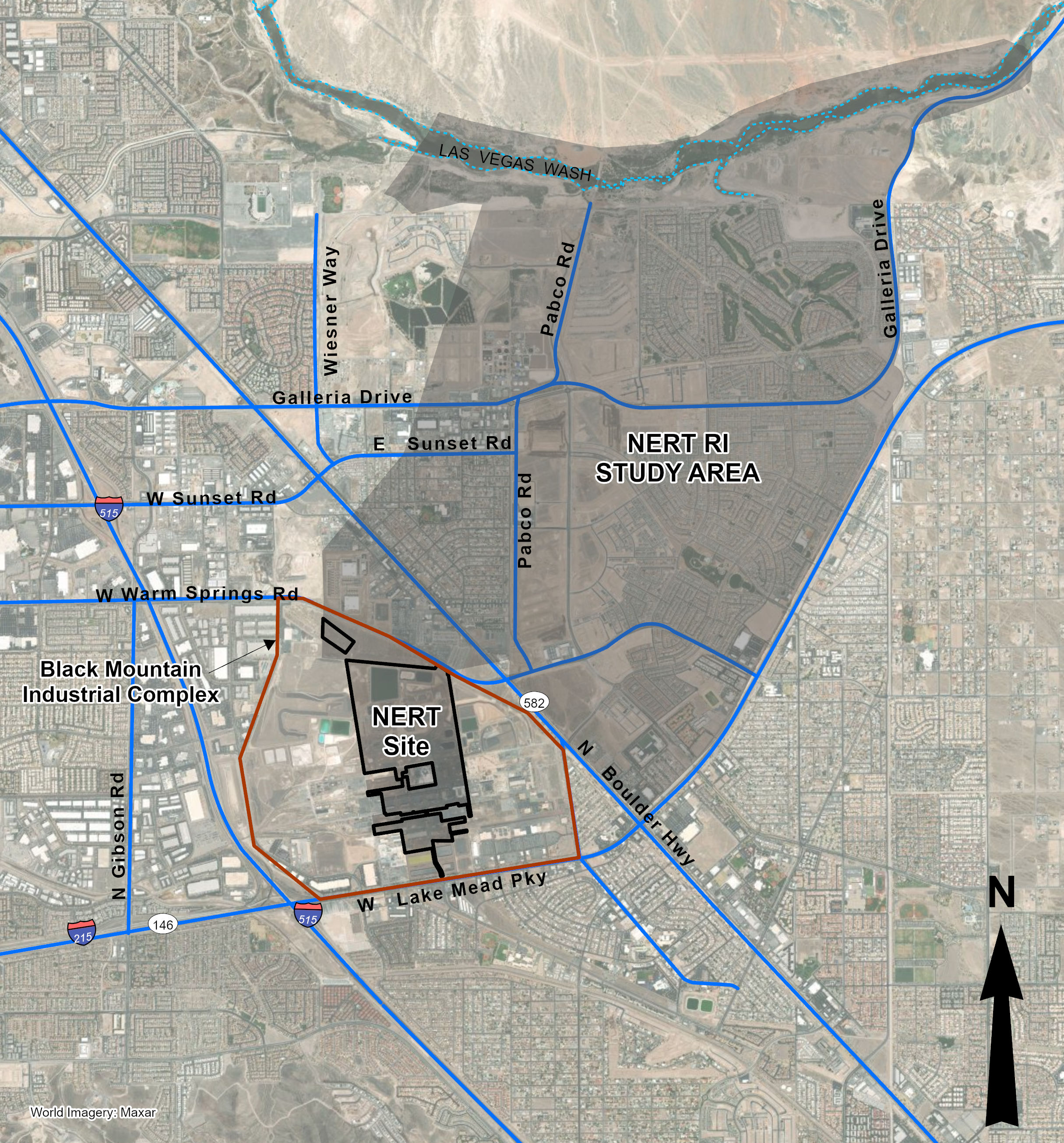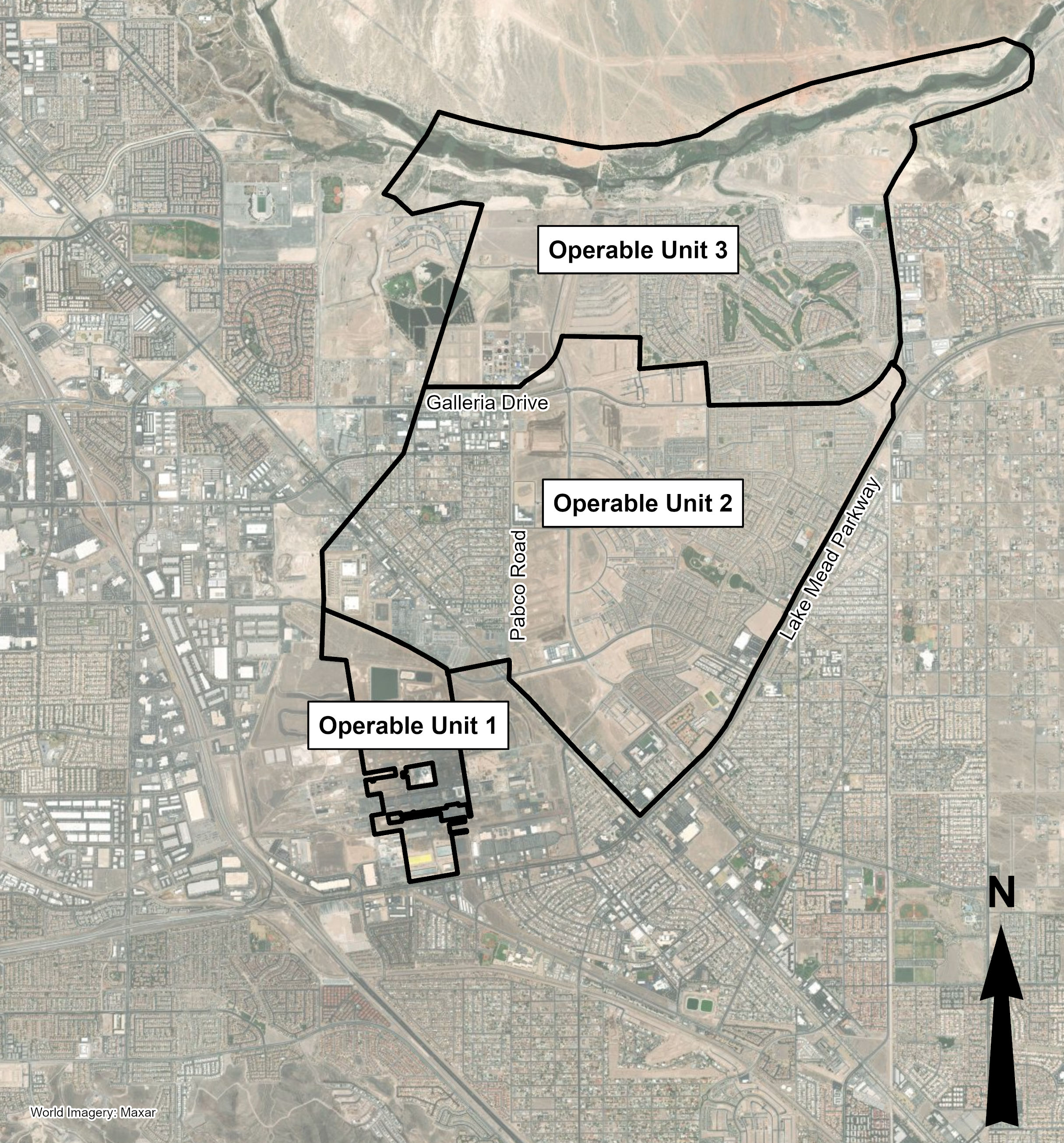The Nevada Division of Environmental Protection (NDEP) and the United States Environmental Protection Agency (USEPA) oversee all investigation and cleanup activities at the Nevada Environmental Response Trust (NERT) Site, which is located within the Black Mountain Industrial (BMI) Complex near Henderson, Nevada. The NERT, also called the Trust, was created in 2011 as part of Tronox Inc.’s (Tronox) bankruptcy and the NERT Site was conveyed to the Trust at that time. The Trust does not conduct any business at the NERT Site. Its sole purpose is to implement environmental cleanup activities to address contamination from historic operations at the NERT Site that occurred prior to the Trust’s formation in 2011.
Historical operations at the NERT Site, which has been used for various industrial operations since 1942, affected soil and groundwater beneath the property with four primary contaminants. Perchlorate and chlorate – the most widespread of the four – were historically manufactured at the NERT Site. These contaminants are often used to produce rocket fuel, missiles, fireworks, flares, and explosives. Two additional contaminants – hexavalent chromium and chloroform – while not manufactured at the NERT Site, have been detected in lesser quantities at the NERT Site. Some of this contamination has moved off-site, as far north as the Las Vegas Wash. Process wastewater from historical operations also migrated northeast of the NERT Site through unlined ditches into unlined ponds. The unlined ditches were not used for process wastewater after 1976 and the unlined off-site ponds have been closed.
Cleanup at the NERT Site follows the environmental rules set by the USEPA and the State of Nevada. NERT is progressing through the cleanup process adhering to the requirements of the Comprehensive Environmental Response, Compensation, and Liability Act, commonly known as CERCLA or Superfund. It is designed to identify, investigate, and clean up sites to protect the public and the environment. The primary objective of the investigation and remediation effort is to mitigate or minimize the movement of contaminated groundwater from the NERT Site to the Las Vegas Wash to be protective of Lake Mead and the Colorado River.
Discovery of Contamination/Initial Investigation – The NERT Site has been the subject of numerous historical regulatory actions and investigations. In the late 1970s, initial oversight by the USEPA, the State of Nevada, and Clark County examined how the entirety of the BMI Complex operations (i.e., not limited to what NERT is currently investigating) might have affected the environment. In the early 1980s, NDEP requested a subsurface investigation that led to the discovery of hexavalent chromium contamination under the NERT Site. In 1997, scientists with the Southern Nevada Water Authority (SNWA) discovered groundwater contaminated with perchlorate near the Las Vegas Wash.
Removal Actions – The first removal action within the NERT Site was undertaken by the former owner, Kerr-McGee, in 1987 and included the construction of a groundwater extraction and treatment system (GWETS) for removal of contaminants from groundwater. The GWETS was expanded and operated by Kerr-McGee, and later Tronox, between 1999 and 2011, and operation continues to this day under the Trust. Soil removal actions designed to remove contaminated soil within the NERT Site were conducted in 2010 and 2011; a soil removal action program was implemented by Tronox from August 2010 to February 13, 2011 and by the Trust, beginning on February 14, 2011 through project completion in November 2011. NERT’s continued cleanup efforts since taking ownership of the Site in 2011 have significantly reduced contamination at the NERT Site. These on-going actions are not the final solution, or remedy, but have significantly reduced risks at and around the NERT Site.
- Since 1987, about 35 tons of hexavalent chromium have been removed from the environment.
- Since 1999, more than 6,500 tons of perchlorate have been removed from the environment, which has significantly reduced the amount of contamination entering the Las Vegas Wash.
- From 2010 to 2019, approximately 585,100 cubic yards of contaminated soil were removed from the NERT Site.
The Trust continues to operate the GWETS, which has reduced perchlorate contamination attributable to the NERT Site in the Las Vegas Wash by more than 90% relative to levels documented in 2000.
The NERT Site’s GWETS has been in continuous operation since 2002. From 2002 to 2024, more than 6,500 tons (about 13.1 million pounds) of perchlorate has been removed from the environment. From 2002 to 2024, about 35 tons (more than 70,000 pounds) of hexavalent chromium has been removed from the environment.
Remedial Investigation (RI) –The Trust investigated the contamination in an established study area called the NERT Remedial Investigation Study Area (NERT RI Study Area), which is shown in the figure below.

The gray-shaded area above represents the NERT RI Study Area.
The NERT RI Study Area includes the NERT Site and areas to the north, east, and northeast of the NERT Site. The NERT RI Study Area is divided into three sub-areas, termed “operable units” or “OUs”, which are shown on the figure below. OU-1 is primarily the NERT Site. OU-2 is located north and east of OU-1. OU-3 is located north of OU-2. Each of the three OUs has its own set of cleanup goals, which are described in greater detail within the Remedial Investigation section.

The figure above shows the three operable units (OUs) comprising the NERT RI Study Area.
The Trust installed groundwater monitoring wells and soil gas probes and collected samples of soil, soil gas, groundwater, and surface water as part of the RI between 2014 and 2023. Over the course of the program, more than 64,000 analyses have been performed on approximately 11,500 samples. These analyses have produced over 480,000 analytical results, ensuring NERT has a comprehensive understanding of the environmental conditions within the Study Area.
The RI Report for OU-1 and OU-2, which describes the findings of the investigations within OU-1 and OU-2, was completed and submitted to NDEP on July 9, 2021. The Trust received NDEP comments on the RI report on February 9, 2022, which the Trust responded to on June 9, 2022. NDEP provided additional comments on August 31, 2022. The Trust responded to NDEP comments and submitted a revision (Revision 1) to the report on August 15, 2023. NDEP provided one comment on December 21, 2023 and one additional comment on January 11, 2024. The Trust responded to NDEP’s comments and submitted Revision 2 of the RI Report for OU-1 and OU-2 on February 13, 2024, which was approved by NDEP on February 26, 2024. The primary objective of this report is to define the nature (i.e., what contaminants) and extent (i.e., where the contaminants are) of the contamination originating from the NERT Site within the boundaries of OU-1 and OU-2. A secondary objective of the report is to characterize the nature and extent of contamination which originates from outside of the NERT site and travels onto, or trespasses on the NERT site. The NERT has accomplished these objectives, and also confirmed that the existing GWETS captures all of the contamination currently moving away from OU-1 toward the Las Vegas Wash. However, groundwater contamination present in the eastern portions of OU-2 and OU-3 continues to migrate towards the Las Vegas Wash and will be addressed in the future as part of the final remedy.
NERT’s planned investigation of contamination in OU-3 is complete. The investigations evaluated potential contamination in soil, soil gas, groundwater, surface water, and sediment, for key constituents of interest, which are being used to evaluate potential risks to human health as well as ecological receptors (e.g., plants and animals) in the Las Vegas Wash. A remedial investigation (RI) report, which details the findings of the investigations within the boundaries of OU-3, is anticipated to be submitted in 2025.
Risk Assessments – NERT has also prepared reports to evaluate potential health risks to human health and the environment. These reports, or risk assessments, which use data from the RI, will be used in the Feasibility Study evaluations (discussed below) for each OU to determine the best cleanup approaches. NDEP approved the human health risk assessment report for OU-1 soil on June 2, 2022; NDEP approved the human health risk assessment report for OU-2 soil gas and groundwater on November 27, 2023; and NDEP approved the human health risk assessment report for OU-1 soil gas and groundwater on January 2, 2024. The human health risk assessment for OU-3 is currently in preparation and is expected to be submitted in 2025. NDEP approved the ecological risk assessment report for OU-1 on February 1, 2024; and NDEP approved the ecological risk assessment report for OU-2 on February 1, 2024. The ecological risk assessment for OU-3 is currently in preparation and is expected to be submitted in 2025. For additional information regarding the risk assessments, see the Risk Assessments page.
Feasibility Study (FS) – The FS will help NERT identify the best tools and technologies for addressing soil and groundwater contamination within the NERT RI Study Area. Several studies, called treatability studies or pilot studies, have been completed or are currently underway to evaluate different cleanup approaches. The goal of each study is to evaluate the effectiveness of a technology or method of destroying or removing contamination. These technologies may eventually be used to supplement or replace NERT’s existing GWETS if the studies determine the new treatment methods are more effective, offer greater longevity, and/or are more efficient.
In addition, NERT is determining the movement and behavior of contaminants in groundwater through the development of a groundwater flow and transport model. The sixth version of the model, or the Phase 6 model as it is called, the most recent version of the groundwater model, was completed in November 2019. The Phase 7 model is in development and is planned for submittal in 2025. The groundwater model and the results of the treatability studies will be used in the FS evaluations. Two FS reports will be prepared for the NERT RI Study Area, one for OU-1 and OU-2 and a separate report for OU-3. Currently, the FS Report for OU-1 and OU-2 is anticipated to be submitted to NDEP in 2025, and the FS report for OU-3 is anticipated to be submitted to NDEP in 2026.
Selection of Proposed Remedy and Records of Decision – Following the FS evaluations, reports will be created that explain the proposed remedy. The public will be invited to attend public hearings on these reports and will be able to review and comment on these reports. After addressing any public comments, NDEP will approve documents that describe the final remedy. Officials call these documents Records of Decision, or RODs. The final remedy will likely combine technologies, monitoring, and administrative actions (e.g., deed restrictions) to address contamination. It is currently anticipated that two RODs will be prepared for the NERT RI Study Area, one for OU-1 and OU-2 and one for OU-3. Currently, the public hearing for OU-1 and OU-2 is anticipated to occur in 2027, and ROD issuance is anticipated to occur in late 2027. The public hearing for OU-3 is anticipated to occur in 2028, and the issuance of the ROD for OU-3 is anticipated to occur in late 2028.
Remedial Design and Remedial Action Implementation – After NDEP issues the RODs, NERT will conduct any additional investigation necessary to finalize remedial design or the construction plans for the remedies defined in the ROD and begin construction of the final remedy.
Last Updated: March 2025
